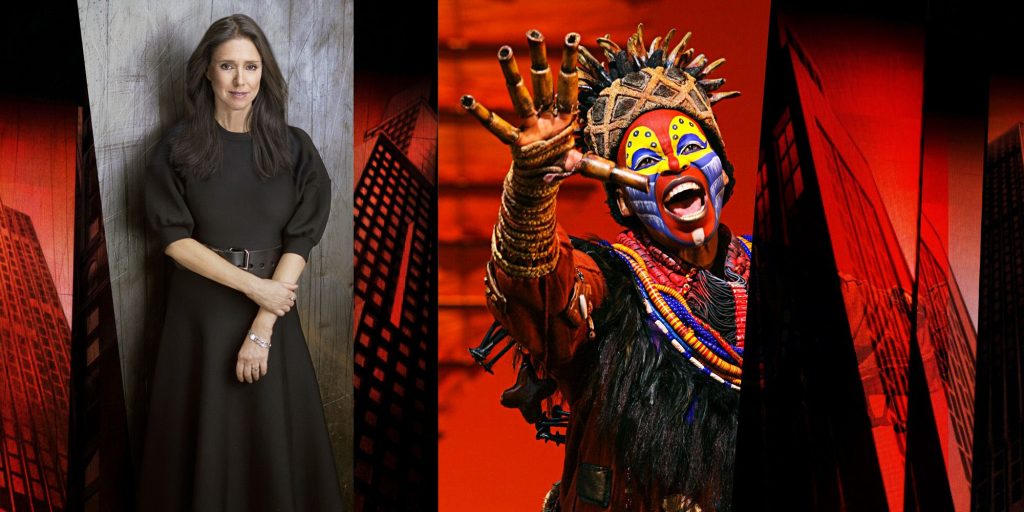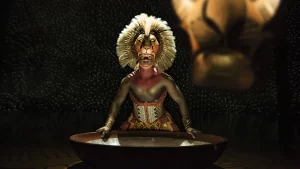Julie Taymor Reflects on the Artistic Triumph of The Lion King Musical
4 min read
JOSEF ASTOR (TAYMOR); JOAN MARCUS (LION KING); WALTER MCBRIDE/GETTY IMAGES (BACKGROUND).

JOSEF ASTOR (TAYMOR); JOAN MARCUS (LION KING); WALTER MCBRIDE/GETTY IMAGES (BACKGROUND).
Disney’s stage adaptation of The Lion King has become a global sensation, captivating audiences since its debut in 1997. As the highest-grossing theatrical production ever, surpassing $10 billion worldwide, it continues to hold its place as a monumental achievement in the world of entertainment. With the musical recently celebrating 25 years in the West End and approaching its 27th year on Broadway, director Julie Taymor shares her insights on the risks and creative decisions that have defined this enduring masterpiece.
When Disney approached Taymor to direct the live adaptation of their beloved 1994 animated film, she was initially hesitant—having never seen The Lion King. However, her curiosity led her to watch the film, and she was immediately captivated. “I thought, well, why not, let’s go look at the movie,” she recalls. The challenge of adapting such a grand narrative fascinated her, particularly the logistics of depicting numerous animals on stage, including the notorious wildebeest stampede.

Taymor embraced a unique theatrical approach, utilizing masks and puppetry to bring the African savannah’s creatures to life. She designed all the costumes and masks, aiming to invite audiences into the imaginative world of the musical. “There is no attempt to hide the human being behind the masks or inside the puppet,” she explains, referring to her technique called the “double event.” This allowed performers to embody both the animal and the human, showcasing Simba’s emotions while reminding the audience of his lion identity.
Disney’s initial lack of a clear vision for the production played to Taymor’s advantage, granting her the creative freedom to explore innovative concepts. Her intention was to highlight the beauty of theater, contrasting it with film’s tendency to conceal its artifice. “In the theatre, we will enjoy seeing a little puppet of a boat, and a big ocean of silk… this is the power of theatre,” she asserts.

Despite the challenges, Taymor’s bold artistic choices transformed The Lion King into a groundbreaking theatrical experience. Early in the development, Taymor proposed three distinct visions for the production, including a commedia dell’arte approach and a more traditional style. Ultimately, she stuck with her original vision, which she described as risky. “The bigger the risk, the bigger the payoff,” she recalls Disney executives saying.
The story of The Lion King also underwent significant transformation. Taymor, working alongside writers Roger Allers and Irene Mecchi, expanded the film’s concise narrative into a two-act musical, enriching character arcs and emotional depth. Recognizing the need for stronger female representation, she enhanced the roles of characters like Rafiki and Nala, infusing the narrative with more complexity and agency.

Incorporating a diverse musical score was another crucial element. While the film featured iconic songs by Elton John, Taymor sought to integrate more traditional African musical styles. She collaborated with South African composer Lebo M, whose contributions added depth and authenticity to the score. “Now I had my population – I had the possibility to have a chorus of birds singing, a chorus of zebras dancing!” she recalls, thrilled by the musical possibilities.
Taymor’s commitment to authenticity also extended to casting. She insisted on a predominantly African and African-American cast, believing it was vital for the show’s integrity. This decision not only provided opportunities for underrepresented performers but also contributed to diversifying the landscape of commercial musicals.

Reflecting on her journey, Taymor acknowledges the challenges and triumphs she faced. The early workshops sparked doubt among some Disney executives, but her determination and innovative ideas ultimately prevailed. Taymor’s exploration of diverse performance traditions—from Japanese puppetry to Indonesian masks—enriched the production’s visual and emotional landscape.
The initial performance of The Lion King was a defining moment for Taymor and her team. As animals paraded down the aisle, the audience erupted in cheers, a reaction they had not anticipated. “In the first performance, people were screaming when the animals came down the aisle—we didn’t expect that. We were so overwhelmed by the audience reaction, we just started crying,” she recalls.
Today, The Lion King remains a landmark production, having captivated over a hundred million viewers worldwide. Its success has paved the way for other innovative musicals that utilize puppetry and creative storytelling. Julie Taymor’s visionary approach has not only redefined musical theater but has also created a lasting legacy that continues to inspire artists and audiences alike.